Shopping Cart
Remove All Your shopping cart is currently empty
Your shopping cart is currently empty
Anti-Galectin-3/LGALS3 Polyclonal Antibody is a Rabbit antibody targeting Galectin-3/LGALS3. Anti-Galectin-3/LGALS3 Polyclonal Antibody can be used in FCM,IF,IHC-Fr,IHC-P,WB.
| Pack Size | Price | USA Warehouse | Global Warehouse | Quantity |
|---|---|---|---|---|
| 50 μL | $220 | 7-10 days | 7-10 days | |
| 100 μL | $374 | 7-10 days | 7-10 days | |
| 200 μL | $527 | 7-10 days | 7-10 days |
| Description | Anti-Galectin-3/LGALS3 Polyclonal Antibody is a Rabbit antibody targeting Galectin-3/LGALS3. Anti-Galectin-3/LGALS3 Polyclonal Antibody can be used in FCM,IF,IHC-Fr,IHC-P,WB. |
| Synonyms | MAC2GAL3, Mac-2, LGALS3, LGALS2, Lectin L-29, L31, L29, GALIG, Galectin3, GALBPCBP35, galactin-3, Gal-3, GAL3, CBP35, AGE-R3 |
| Ig Type | IgG |
| Reactivity | Human,Mouse (predicted:Rat,Dog) |
| Verified Activity | 1. Sample: SW480 (Human) Cell Lysate at 40 μg Primary: Anti-Galectin 3 (TMAB-00735) at 1/300 dilution Secondary: IRDye800CW Goat Anti-Rabbit IgG at 1/20000 dilution Predicted band size: 29 kDa Observed band size: 29 kDa 2. Sample: MCF-7 Cell (Human) Lysate at 40 μg NIH/3T3 Cell (Mouse) Lysate at 40 μg Primary: Anti-Galectin 3 (TMAB-00735) at 1/300 dilution Secondary: IRDye800CW Goat Anti-Rabbit IgG at 1/20000 dilution Predicted band size: 29 kDa Observed band size: 29 kDa 3. Blank control: A431. Primary Antibody (green line): Rabbit Anti-Galectin 3 antibody (TMAB-00735) Dilution: 1 μg/10^6 cells; Isotype Control Antibody (orange line): Rabbit IgG. Secondary Antibody: Goat anti-rabbit IgG-AF647 Dilution: 1 μg/test. Protocol The cells were fixed with 4% PFA (10 min at room temperature) and then permeabilized with 90% ice-cold methanol for 20 min at-20°C. The cells were then incubated in 5% BSA to block non-specific protein-protein interactions for 30 min at room temperature. Cells stained with Primary Antibody for 30 min at room temperature. The secondary antibody used for 40 min at room temperature. 4. Sample: Lane 1: Siha (Human) Cell Lysate at 30 μg Lane 2: U87MG (Human) Cell Lysate at 30 μg Lane 3: A431 (Human) Cell Lysate at 30 μg Lane 4: LOVO (Human) Cell Lysate at 30 μg Lane 5: MCF-7 (Human) Cell Lysate at 30 μg Lane 6: Hela (Human) Cell Lysate at 30 μg Primary: Anti-Galectin 3 (TMAB-00735) at 1/1000 dilution Anti-beta-Actin at 1/2000 dilution Secondary: IRDye800CW Goat Anti-Rabbit IgG at 1/20000 dilution Predicted band size: 26 kDa Observed band size: 28 kDa 5. Paraformaldehyde-fixed, paraffin embedded (human gastric carcinoma); Antigen retrieval by boiling in sodium citrate buffer (pH6.0) for 15 min; Block endogenous peroxidase by 3% hydrogen peroxide for 20 min; Blocking buffer (normal goat serum) at 37°C for 30 min; Antibody incubation with (Galectin 3) Polyclonal Antibody, Unconjugated (TMAB-00735) at 1:400 overnight at 4°C, followed by a conjugated secondary for 20 min and DAB staining. 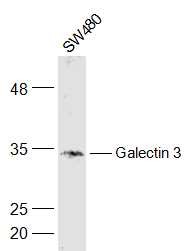 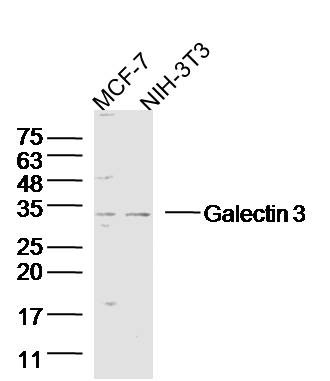 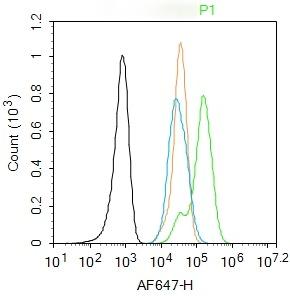 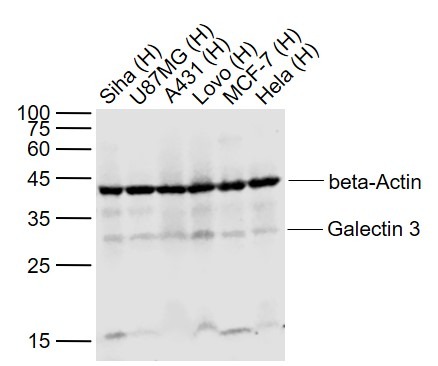 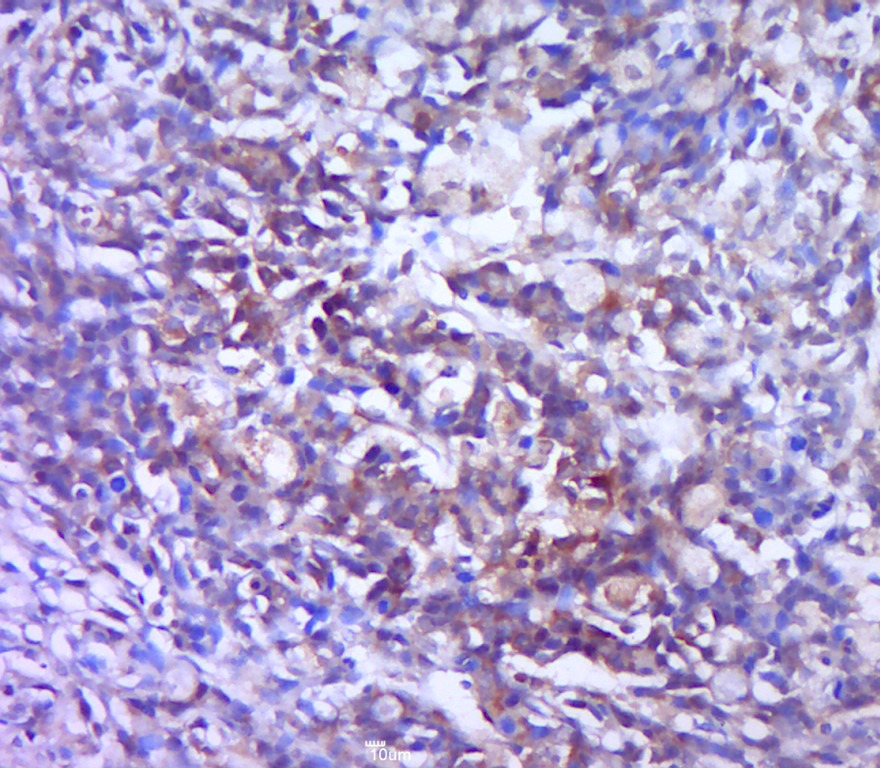 |
| Application | |
| Recommended Dose | WB: 1:500-2000; IHC-P: 1:100-500; IHC-Fr: 1:100-500; IF: 1:100-500; FCM: 1ug/Test |
| Antibody Type | Polyclonal |
| Host Species | Rabbit |
| Subcellular Localization | Cytoplasm. Nucleus. Secreted. Note=Secreted by a non-classical secretory pathway and associates with the cell surface. |
| Tissue Specificity | A major expression is found in the colonic epithelium. It is also abundant in the activated macrophages. |
| Construction | Polyclonal Antibody |
| Purification | Protein A purified |
| Appearance | Liquid |
| Formulation | 0.01M TBS (pH7.4) with 1% BSA, 0.02% Proclin300 and 50% Glycerol. |
| Concentration | 1 mg/mL |
| Research Background | This gene encodes a member of thegalectinfamily of carbohydrate binding proteins. Members of this protein family have an affinity for beta-galactosides. The encoded protein is characterized by an N-terminal proline-rich tandem repeat domain and a single C-terminal carbohydrate recognition domain. This protein can self-associate through the N-terminal domain allowing it to bind to multivalent saccharide ligands. This protein localizes to the extracellular matrix, the cytoplasm and the nucleus. This protein plays a role in numerous cellular functions including apoptosis, innate immunity, cell adhesion and T-cell regulation. The protein exhibits antimicrobial activity against bacteria and fungi. Alternate splicing results in multiple transcript variants.[provided by RefSeq, Oct 2014] |
| Immunogen | KLH conjugated synthetic peptide: human Galectin 3 |
| Antigen Species | Human |
| Gene Name | LGALS3 |
| Gene ID | |
| Protein Name | Galectin-3 |
| Uniprot ID | |
| Biology Area | Nuclear Proteins,Cell differentiation |
| Function | Galactose-specific lectin which binds IgE. May mediate with the alpha-3, beta-1 integrin the stimulation by CSPG4 of endothelial cells migration. Together with DMBT1, required for terminal differentiation of columnar epithelial cells during early embryogenesis. In the nucleus: acts as a pre-mRNA splicing factor. Involved in acute inflammatory responses including neutrophil activation and adhesion, chemoattraction of monocytes macrophages, opsonization of apoptotic neutrophils, and activation of mast cells. |
| Molecular Weight | Theoretical: 29 kDa. |
| Stability & Storage | Store at -20°C or -80°C for 12 months. Avoid repeated freeze-thaw cycles. |
| Transport | Shipping with blue ice. |
| Size | Quantity | Unit Price | Amount | Operation |
|---|

Copyright © 2015-2025 TargetMol Chemicals Inc. All Rights Reserved.